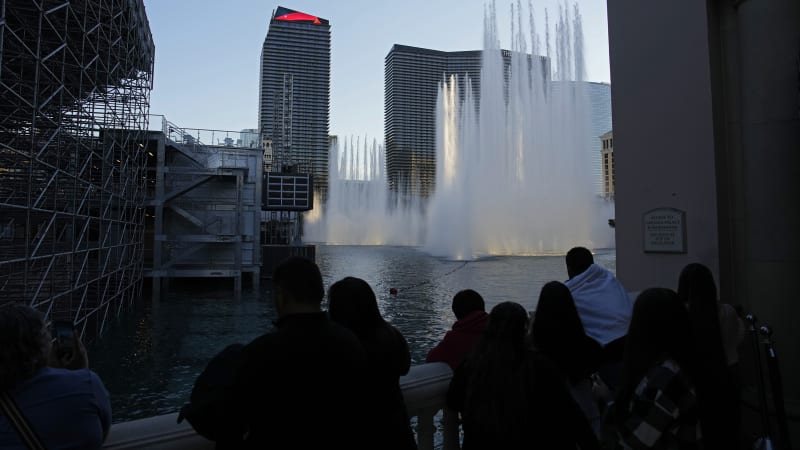
People watch the fountains at the Bellagio hotel-casino behind grandstands installed ahead of the Las Vegas Formula One Grand Prix auto race Friday, Nov. 10, before the water was shut off. (AP)
LAS VEGAS — The famous fountains at the Bellagio won’t be very visible this week amid the roar of Formula One racing on the Las Vegas Strip, and gondoliers won’t be serenading tourists at the Venetian resort.
“Fountains have been shut off, canals drained, streets closed or harder to navigate,” Michael Green, a University of Nevada, Las Vegas history professor, said after six months of road work and temporary grandstand construction for some of the most monied spectators in sports. “What are they calling it? Stripmageddon? It is clearly causing a lot of uproar.”
“But this is a different kind of big event,” said Green, who remembers two Grand Prix races held 42 years ago at Caesars Palace. “We’re talking about billionaires from around the world. They’re going to bring in a ton of money. They’re not necessarily the usual tourist.”
Organizers, local officials and hotel operators believe the discomfort will be forgotten after racing ends late Saturday. They hope Las Vegas will join Monaco on the leader board of host cities for Grand Prix events around the world.
But predictions of sold-out seats and peak demand for the most expensive grand prix on the F1 calendar may have been overly optimistic. Tickets were still available this week, and some hotels have slashed room rates.
Post-race, officials say the Venetian gondola canal will be refilled and casino operator MGM Resorts International has promised to replace Bellagio sidewalk shade trees removed to frame the fountains with thousands of grandstand seats and skybox suites. One worker died during construction.
“I know a lot of people love the fountains,” Joshua Guray, a visitor from Long Beach, California, said. “So it’s definitely a bummer, I’d say.”
For now, many familiar Strip sights are blocked by track barriers, fencing, pedestrian walkway screens, scaffolding and advertising erected around the nighttime race on streets usually choked with taxis, buses and rental cars and lined by pedestrians posing for selfies.
“It’s all barricades and things blocking traffic,” said Charles Flexer, a tourist from Williamsport, Pennsylvania, who tried to decide how to cross Las Vegas Boulevard with his mother using an electric mobility scooter. “It’s very disruptive.”
When the inaugural Formula One Las Vegas grand prix was added to a 24-race worldwide F1 schedule a year ago, tickets and hotel packages costing tens of thousands of dollars per person went on sale. Organizers won a 10-year permit for the race.
After road work began in April, race organizers asked Clark County to contribute half of an estimated $80 million in repaving costs. Jim Gibson, chairman of the elected body with jurisdiction over the Las Vegas Strip, said last week that talks about who pays what will continue after the race.
“Formula One is in a class all its own” Gibson said. “By any standards, it’s been a very heavy lift for our community to take the steps necessary to have a successful event. Everyone who lives here, who works in the resort corridor in particular, has had to sacrifice because of the significant roadwork and construction.”